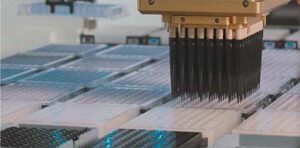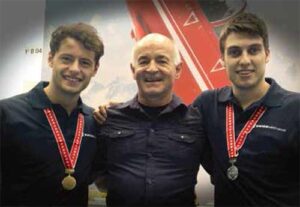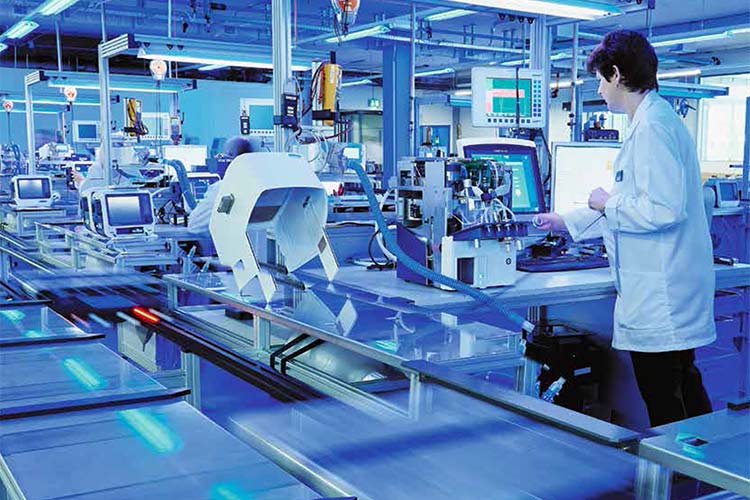Hamilton is a global leader in laboratory automation and medical technology. The head office of the family-run company is located in Bonaduz, a mountain village in the Swiss Alps.
Working where others go on vacation, in Graubünden, Switzerland’s no. 1 vacation hot spot is a reality thanks to Hamilton Bonaduz AG. The company with it’s head office in the idyllic mountain village of Bonaduz is one of the largest employers in South-East Switzerland and has

been growing rapidly for many years. So rapidly, in fact, that it can barely cover its demand for well-qualified employees, and there is no end in sight to this growth. On the contrary: 200 new jobs will be created over the next two years. Hamilton is therefore making great efforts to attract qualified staff from the metropolitan areas to the sparsely populated Canton of Graubünden. 170 days of sunshine per year, hundreds of kilometers of ski pistes and mountain bike trials in the immediate vicinity make the offer even more attractive.
Opportunities through vocational training
At the same time, the company tackles the problem by placing greatest importance on its own vocational training. In the present time, Hamilton employs 59 trainees – mainly polytechnicians (20) and design engineers (13). Elias Kalt, Head of Production, is responsible for training the polytechnicians. “Our own experts are our insurance for the future,” he comments. The state-of-the-art operations, varied work and great importance placed on vocational training give trainees the advantage of a top-class qualificationqualification, he adds. Riccardo Bieler is one example of the high quality of training provided by Hamilton. He came in eighth place at the WorldSkills Leipzig 2013. Participating in the vocational world championships alone is an achievement in itself as only the best trainees of each country in each vocation are able to enter the competition. Straight after completing his training, Riccardo Bieler won the 2012 Swiss master title in CNC turning and thus secured himself the ticket to the world championships. That year, Hamilton had two reasons to celebrate: Remo Cadonau won silver in CNC milling. “The next potential

candidates are already raring to go,” announces Elias Kalt. He knows what he is talking about: he has supported and trained several young Hamilton polytechnicians for the Swiss and world championships in recent years.
Breakthrough thanks to microliter syringe
Clark Hamilton, the founder of the company, is the reason why Hamilton requires such a large number of qualified staff and announces record sales every year. The American Chemical Engineer created his masterpiece in a small garage in 1947. He invented the microliter syringe, the first syringe for measuring and pipetting in the microliter range, which has become an integral part of all modern hospitals and laboratories.
This was Clark Hamilton’s breakthrough. His business in the USA started up quickly, bringing with it the inevitable expansion into Europe. He took the risk of personally crossing the Atlantic to search for a suitable production site in Europe. As he loves the mountains, he also travelled to Switzerland where he discovered the perfect location in Bonaduz. He found the place to be ideal as it was close to the Zurich Airport and, of course, the mountains. His office in the new building constructed in 1960 was designed so that he could enjoy the phenomenal view of the glaciers nearby.
The company remains family-run to this day – and Clark Hamilton’s groundbreaking innovation is still the foundation for the syringe production. The company founder’s invention has been often copied by now, which is why Hamilton has established additional company pillars, namely the divisions Medical, Liquid Handling and Laboratory Automation.

Hamilton’s key pillar, the Medical Division, specializes in the development and production of innovative ventilators. The aim of these products is to improve the life of ventilated patients. They are primarily used in hospital intensive care units, and the Swiss air rescue service REGA also trusts these products “Made in Switzerland”. It is becoming apparent that digitalization does not stop at ventilators. Hamilton ventilators are fitted with intelligent control units with microprocessors and touchscreen operation.
“Problem solved” with KAISER tools
Whereas barely any machining is required in the Medical Division, the Robotics Division, which develops fully automated robotics systems, has been relying on KAISER tools for many years. The production of the “96 Probe head”, a specialized robot that can fill 96 syringes at once to the exact microliter, is an example of how these tools are being used. The pipette positions must be absolutely exact, which is why all holes are drilled with extremely accurate tolerances – a complex task considering the depth of the drill holes. Andreas Rageth, Team Leader Milling, is one of Hamilton’s 80 machining specialists. He places great value on KAISER turning tools due to their reliability. He feels that this is indispensable as the company’s operations are becoming increasingly automated. “We cannot afford to make any compromises. That’s why we often tell ourselves that we turn to achieve the required precision.” At Hamilton, KAISER turning tools stand for “problem solved”, he adds. Although Hamilton continuously monitors its established processes and also tests new approaches, KAISER tools have beat the competition time and time again.
Even the company location in Bonaduz has long become an attraction in Andreas Rageth’s eyes. “The countryside, people and weather are all excellent.” The passionate biker also loves the numerous mountain passes with little traffic – sparsely populated areas have their advantages.


